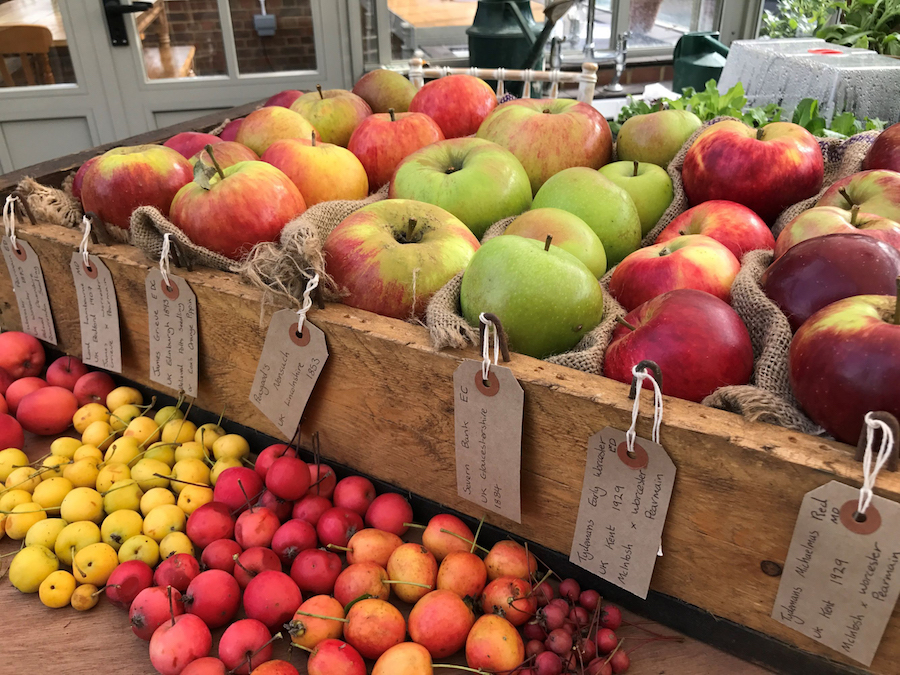Got a glut of apples? 6 ideas for using them up
Apple growers have reported a bumper harvest this year, thanks to the scorching summer. But if you’ve a glut, how are you going to store them all?
You’ll probably have already got through early varieties, which are ready from late-July to September and don’t keep, so are best eaten straight from the tree or made into juice, cider or dried apple rings. These include ‘George Cave’, a dessert type which fruits from late-July, and the cooking apple ‘Grenadier’.
Later varieties can be left on the tree until mid-October, unless really windy weather is predicted. Mid-season apples can be kept for a few weeks, while late ones will last you until next year. Good long-keepers include ‘Granny Smith’, ‘Winston’, ‘Tydeman’s Late Orange’ and ‘Brownlees Russet’.
Here’s how to pick and store them, plus six ideas for using them up…
When do you pick them?

Select the right time for picking
Notice how the fruit looks and smells. The way the fruit feels when you pick it will also help you assess if it’s ripe. Lift the fruit in your hand, twist it gently and if it comes off the tree easily then it should be ripe.
Be really careful when picking them as one bruise or blemish will cause the apple to rot. The little bit of stem should stay in the apple too. The best-keeping varieties hang on the trees through October and are only gathered before a hard frost hits them.
How to store them

Store apples in wooden crates
The traditional method of storing apples is to use wooden trays, which are placed on top of one another leaving space for ventilation, as air circulation will help stop the fruit rotting.
Wooden orchard boxes are most commonly used, although you can also store apples in polystyrene containers with holes in them, or in fibre trays. Wrap each individual apple in newspaper and place them folded side down in the tray, ensuring that the individual fruits aren’t touching. Store them in a frost-free, cool, dark place which isn’t too dry, such as a shed.
6 ways to preserve your apples
Unsure what to do with them next? Here are some ideas…
1. Use a fruit press

Make delicious juice using an apple press
If you don’t have anywhere to store them, consider investing in a fruit press. Freshly pressed juice will keep in the fridge for a few days. Or, if you have plenty, pour it into clean plastic bottles, leaving a couple of centimetres for expansion, and freeze the juice.
2. Cook up some chutney

Apple chutney should last for months
Apples make a great addition to chutneys, mixed with a combination of vinegar and salt or sugar, plus onions, garlic and a range of herbs, spices and sugar. Most chutneys will keep in a sealed jar for up to a year. But once open, refrigerate and eat within a few months.
3. Make apple butter

Apple butter is a great sweet addition to toast
If you have a slow cooker, this is ideal for making your own apple butter to spread on toast or to glaze ham with. The peeled, cored and chopped apples are mixed with sugar (or maple syrup, if you want to cut out the refined sugar), cinnamon, cloves and salt and then cooked slowly for nine to 10 hours until the mixture is thickened and dark brown, ready to transfer into sterilised glass jars.
4. Cook and freeze

Cook apple to freeze
Cooked apple – whether it’s still chunky enough to go into a pie or soft and smooth enough for a sauce – freezes beautifully.
Just peel, core, chop into large chunks, add sugar to taste (although I prefer them tart) and a little water to stop the apples sticking to the bottom of the pan, keep an eye on them and cook according to how soft you want the pieces to become. Allow them to cool and transfer to airtight containers before labelling and putting in the freezer. They will keep for months.
5. Make crab apple jelly

Make jelly with crab apples
Crab apples are brilliant for making jelly. If you have a glut of crab apples, wash them and cut them up without peeling or coring, put them into a large saucepan and add enough water to just cover the fruit.
Simmer until the fruit is soft and has broken down, then strain through a muslin or tea cloth, without forcing the liquid out. This may mean leaving them overnight.
Measure the juice and return it to a clean pan, warming it up, adding 10 parts juice to seven of sugar and stir until dissolved. Bring to the boil and continue boiling until setting point (about half an hour), when it will solidify on the back of the spoon. Remove any surface scum, pour it into warm sterilised jars, cover and leave to set. Once you have opened the jar, keep it in the fridge and it should last a few weeks.
6. Dry them

Dried apple makes a delicious snack
Peel, core and finely slice your apples across, so they form circles with a hole in the middle. Dunk them in a bowl of water adding a little vinegar or lemon juice to stop them going brown, then leave for around half an hour.
Next, dry them on a tea towel and place onto stainless steel cooling racks and transfer to a barely-warm oven for a few hours, until they are leathery and dry to the touch. Tear one to check there is no retained moisture and if there is, leave them a little longer.
Once out of the oven and cooled, store in an airtight container. They should keep for several months.
The Press Association
Latest posts by The Press Association (see all)
- Could brisk walking boost your heart? - April 16, 2025
- Best spring-to-summer plants to fill the colour gaps - April 15, 2025
- Catherine tells how ‘spiritual’ connection with nature gives her peace in busy world - April 15, 2025
- Why weeds are worth cultivating – and eating - April 14, 2025
- 5 top tips for cleaning your tech, from phones to laptops - April 14, 2025




















